Toxic Dirt + Avian Flu = Science Fair Success
Fifteen-year-old Nolan Kamitaki shows what it takes to become one of America's top young scientists.
By Emily Sohn
When Nolan Kamitaki won the $20,000 scholarship grand prize at last year’s Discovery Channel Young Scientist Challenge (DCYSC), he was stunned.
“I saw the camera focus on me, and I stood up,” says Nolan, who will be a sophomore this fall at Waiakea High School in Hilo, Hawaii. “After that,” he recalls, “It was really a dreamlike sequence.”
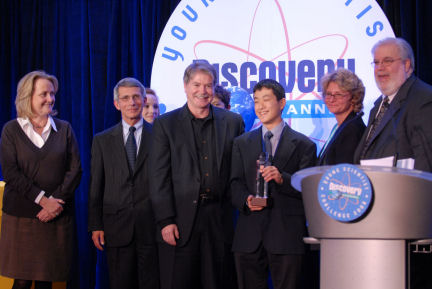 |
|
Nolan Kamitaki wins the grand prize award at DCYSC in 2006. Surrounding him are (from left) Judith McHale, president & CEO, Discovery Channel; Anthony Fauci, director, National Institute of Allergy and Infectious Diseases, NIH; John Hendricks, founder and chairman, Discovery Channel; Elizabeth Marincola, president, Science Service; and Steve “Jake” Jacobs, DCYSC head judge.
|
| Courtesy of Discovery Channel |
Nolan’s previous success at science fairs made him eligible to compete in the 2006 DCYSC. And this year, his most recent work landed him at a second prestigious competition—the Intel International Science and Engineering Fair (ISEF).
Toxic metal in Hawaii
Nolan’s road to science fair stardom began when he was in seventh grade. He had read some newspaper articles about high levels of arsenic—a toxic metal—found in Hilo’s soil. Arsenic can damage the skin, lungs, heart, and other organs. It can interfere with kids’ ability to learn. In high enough quantities, it can be fatal.
Small amounts of arsenic occur naturally in the Earth, but larger, more dangerous amounts can arise from the metal’s use in industry. Particles of arsenic can float in the air as dust. And if arsenic gets into the soil, it can contaminate drinking water and crops. Nolan wondered whether the arsenic in Hilo’s soil could be getting into kids’ bodies too.
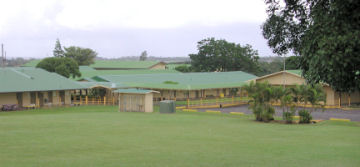 |
|
The discovery of arsenic in Hilo’s soil made Nolan wonder whether the toxic metal lurked in the ground near his school, Waiakea Intermediate School, pictured here.
|
| Nolan Kamitaki |
Nolan collected samples of soil from the grounds of several schools near his home. He also collected hair samples from students who attended those schools. If the kids had been exposed to high levels of arsenic, the toxic material would show up in their hair. He analyzed the soil and hair samples to determine their arsenic levels.
His analyses showed that the soil was highly polluted with the metal but that there wasn’t enough of it in the students’ hair to put them at risk of arsenic poisoning.
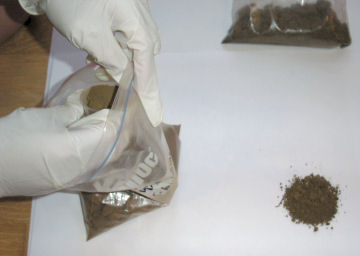 |
|
Nolan looked for traces of arsenic in soil samples from his area.
|
| Courtesy of Nolan Kamitaki |
“It’s a controversial issue,” Nolan says. “It surprises people who think of Hilo as such a paradise. It’s hard to believe there could be a [pollution] problem like this.”
Discovery Channel challenges
Nolan’s work earned him a spot at last fall’s DCYSC. For this annual event, the Discovery Channel brings together 40 middle school science fair winners to compete for scholarship money, prizes, and the title of “America’s Top Young Scientist of the Year.” Students are given a number of scientific challenges and are judged on their problem-solving skills as well as their ability to work as part of a team.
Last year’s DCYSC took place at the National Institutes of Health (NIH) in Bethesda, Md. Participants worked with NIH scientists on real problems, all with a medical theme.
Nolan’s favorite challenge of the competition was called “Avian Flu: Something in the Air.” For that 90-minute activity, each member of his five-person team took on a role, such as doctor, town mayor, or virus specialist. Nolan’s role was to be the team’s epidemiologist—a doctor who studies disease patterns.
The team’s first job was to diagnose a case of avian flu. (To do this, the students received information about a fake patient.) The team then had to devise a treatment plan. The group’s third task was to hold a press conference to tell community members about the outbreak and explain what they should do to prevent it from spreading. The work had to be done within a tight time frame.
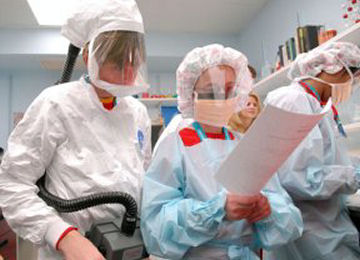 |
|
In a lab at the National Institutes of Health, student scientists Jack Grundy (left) and Erin Edwards tackled a make-believe avian-flu epidemic while participating in the 2006 Discovery Channel Young Scientist Challenge.
|
| Photo by Bill Fitzpatrick |
“I got to predict how many people survived and how many became infected,” Nolan says. “It was the most exciting challenge to me because it is relevant today.”
Following up on flu
That 90-minute challenge inspired Nolan to study avian flu, also called H5N1, for his next science fair project.
Avian flu has been killing birds around the world. The virus that causes the flu has recently mutated, or changed, into a form that allows people to catch it from birds. Like birds, people can get sick and even die from the illness. And while the virus can’t yet spread from person to person, scientists fear that if it mutates again, it will gain the ability to do so. That could cause a worldwide epidemic.
The disease spreads rapidly, Nolan says. So, in the case of an epidemic, there wouldn’t be enough time to make enough vaccine to protect everyone. Governments would have to decide who should get the limited supply of vaccine. For his science fair project this year, Nolan decided to try to find the best strategy to minimize the extent of an avian-flu epidemic by vaccinating the people who would be most responsible for its spread.
“It’s an important problem right now,” he says. “Scientists have to figure out how to deal with the threat of disease. As soon as they know, they have to already have a plan of action.”
Virtual virus
Nolan’s first job was to design a computer program that simulated how avian flu would spread through a city. He spent 4 months researching and writing the program. First, he collected data about H5N1 from the Centers for Disease Control and Prevention (CDC), medical journals, and other sources. Then, he divided the population into three groups by age: youths, adults, and the elderly.
His simulations considered how long people of each age group tend to interact with other people, how long they are contagious before showing symptoms of the flu, and how likely they are to die from it, among other factors.
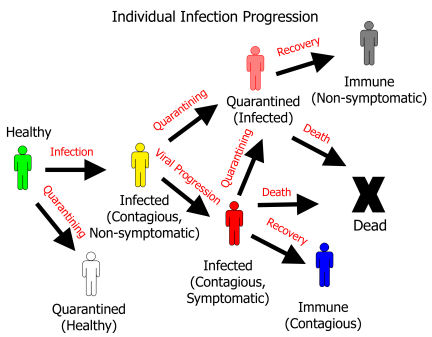 |
|
With his computer program, Nolan considered the many ways in which an infectious disease can spread.
|
| Courtesy of Nolan Kamitaki |
To consider each possible scenario, Nolan ran the computer program 18,000 times. Analyzing the data took about a month. In the end, he found that the best way to stop an epidemic in its tracks would be to vaccinate kids and teenagers. Compared with adults, kids interact with a greater number of people each day, he says, so they tend to spread diseases more quickly.
The project taught Nolan a lot about computer science. “You have to go through a lot of revisions to get something you can work with,” he says.
You win some . . .
Nolan’s work on avian flu earned him a spot at this year’s ISEF, which took place in Albuquerque, N.M. in May. During the competition, more than 1,500 high school students from 51 countries competed for $4 million in scholarship money, computers, trips, and other prizes.
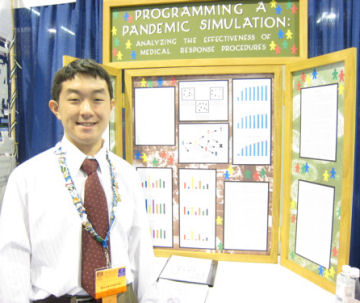 |
|
Nolan presented his work on avian flu at the 2007 International Science and Engineering Fair in Albuquerque, N.M.
|
| Emily Sohn |
Although he didn’t win a prize this year, Nolan is more motivated than ever. “It was thrilling to be able to attend a large science fair and meet so many talented students,” he says. “The opportunity to learn about many really great scientific ideas was a valuable experience.”
Next year, he plans to write a more advanced program that analyzes how avian flu could spread between cities and through other means. Merging medicine with computer science, he says, will be the key to preparing for future disease outbreaks.
“The interdisciplinary approach to science fascinates me,” Nolan says. “Science can’t be completed by one person or one team alone. The connections between groups are what will bring science together.”







